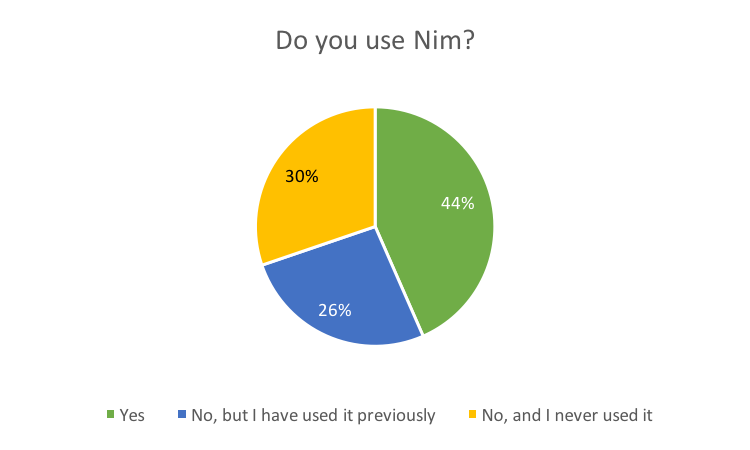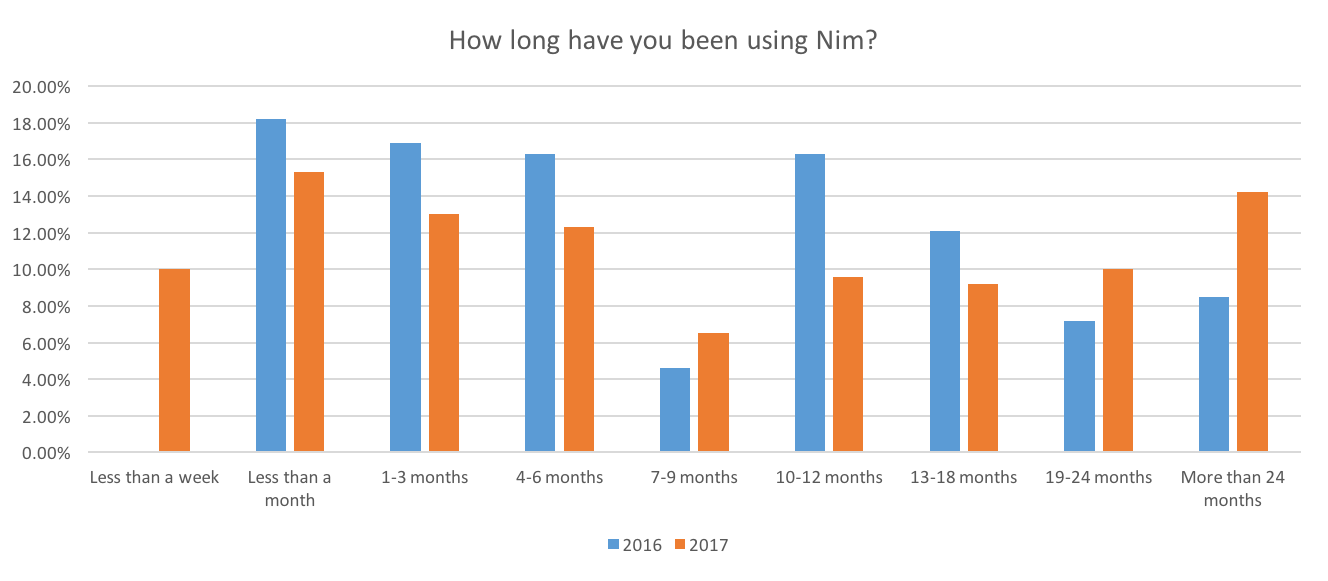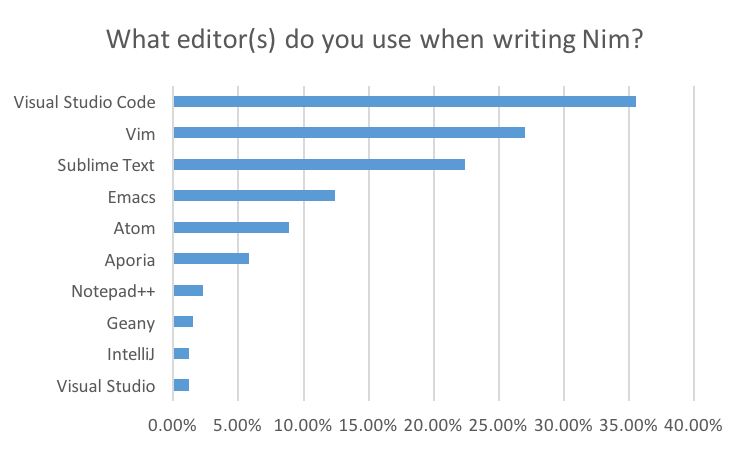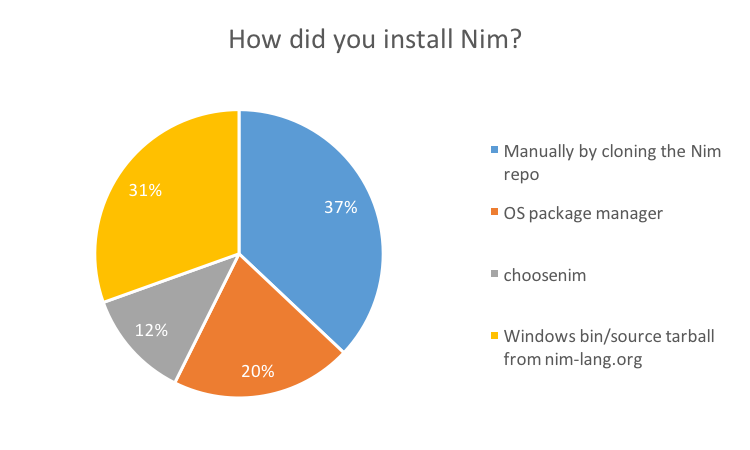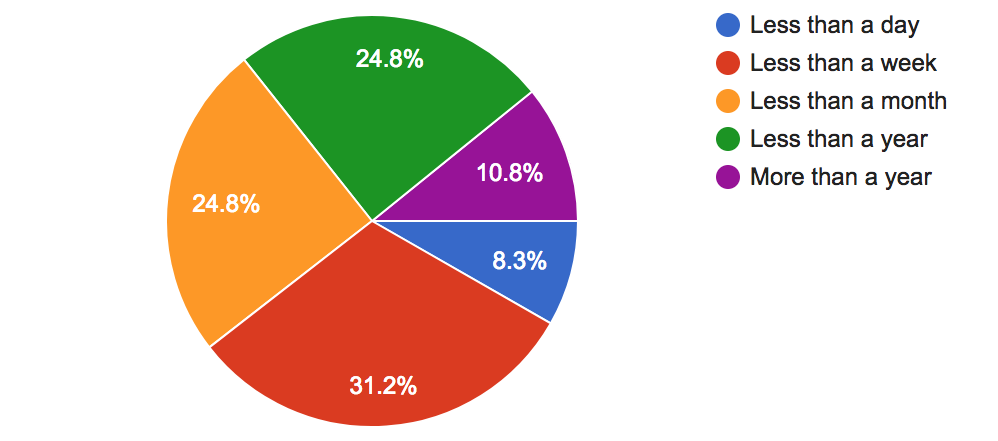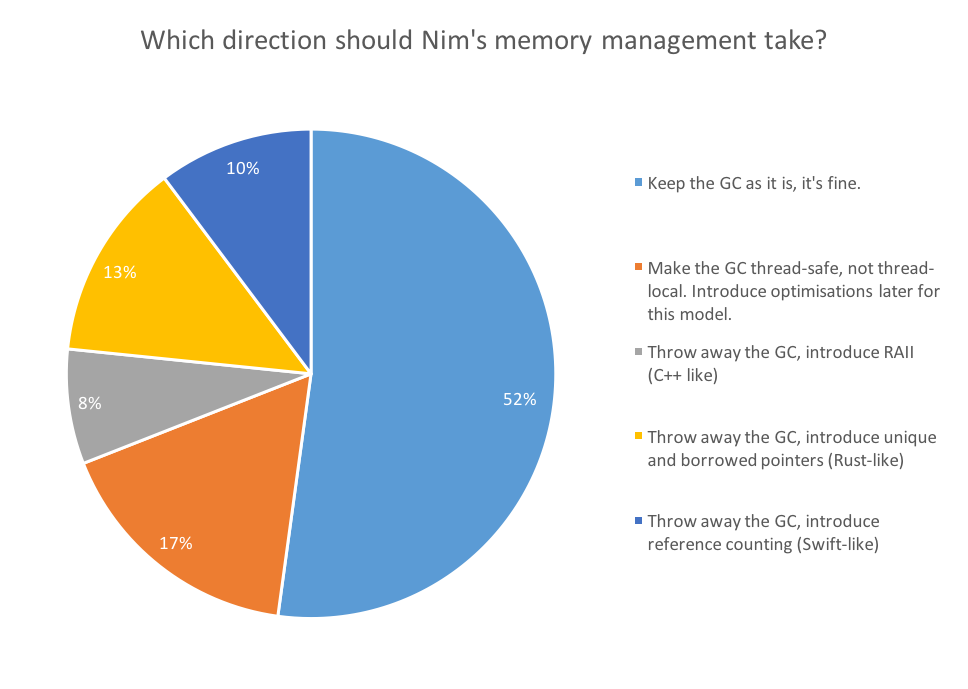Nim Community Survey 2017 Results
01 October 2017 Dominik Picheta
We have recently closed the 2017 Nim Community Survey. I am happy to say that we have received exactly 603 responses, huge thanks go to the people that took the time to respond. We’re incredibly thankful for this very valuable feedback.
For the results of the previous year’s survey, take a look at the 2016 results analysis.
Our survey ran from the 23rd of June 2017 until the 14th of August 2017. The goal of this survey was to primarily determine how our community is using Nim, in order to better understand how we should be improving it. In particular, we wanted to know what people feel is missing from Nim in the lead up to version 1.0. We have also asked our respondents about how well the Nim tools worked, the challenges of adopting Nim, the resources that they used to learn Nim and more. We repeated the survey with the same questions this year to see how we did over the past year.
Unlike in the last year, this analysis will not go over all the results. Instead it will only go over the most interesting answers.
A word on the response count
In comparison to last year we unfortunately received 187 less responses. I suspect the reason for this decrease was the fact that we were not able to advertise the survey as well as the previous year, I got lucky last year by sharing a link to our survey in the Rust community survey results Hacker News thread. This year Rust’s results were late and so I didn’t get the same opportunity.
But with that in mind I think the number of responses is still good.
Do you use Nim?
Like last year we split up our respondents into three groups:
- Current users of Nim
- Ex-Nim users
- Those that never used Nim
This allowed us to ask each group specific questions. For example, we asked ex-Nim users why they’ve stopped using Nim.
This year the proportion of responses from current Nim users has grown from 39% to 44%, and as a result of this there is less responses from those that never used Nim (decrease from 37% to 30%). This is likely due to a higher proportion of responses from the Nim community.
But this isn’t the whole story, the number of ex-Nim users went up from 24% to 26%.
Nim users
This section includes answers from current Nim users only (44% of respondents).
How long have you been using Nim?
Just like last year, a large proportion of our Nim users are new. This suggests that our community is growing and is a good sign. On the other end of the spectrum we can see that there is a significantly higher number of Nim users that have been using Nim for more than 24 months.
Nim at work and project size
The questions related to these topics got very similar results to last year:
- 57.1% of Nim users’ projects are less than 1,000 lines of code.
- 24.6% of Nim users’ work with Nim either full-time or part-time.
- 52.5% of Nim users plan to use Nim at work.
How is Nim being used at work?
This was a free-form question so I will just pick out some of the common and interesting answers. According to the respondents, Nim is used at work for:
- Command-line applications
- Server-side analytics
- DevOps
- Scientific computing
- Speeding up Python
How could we help make Nim more accepted at your company?
Another free-form question, I will pick out some of the things that respondents have identified:
- Release of version 1.0 (a common theme)
- Mature libraries and stability (a common theme)
- Up to date documentation of every feature, with examples (a common theme)
- More tutorials and videos
- Enhance the stdlib, it needs to be more complete
- Corporate sponsor
- Visual Studio plugin
- Lowering the barrier to entry for working with cross-compilers and interop with C
- Free book
- Compelling use cases
- Porting to ARM cortex M (already done?)
- “change cocky logo”
- More informative errors
- Lockfile support
- Interfaces
- More data processing tools
- GUI creator for Windows
- “idk lol”
Nim and its tools
In this section of the survey, we wanted to find out the tools that Nim users are utilising when developing Nim applications.
What editor(s) do you use when writing Nim?
Programmers swear by their editors. What does the Nim community prefer?
There is still a large number of Vim users, but now they are overwhelmed by the Visual Studio Code users. VS Code has gone from 16.5% to 35.5%!
Operating systems, Nim version and Nim code breakage
Again, the results for these questions are very similar to last year. I will simply provide a summary:
- Linux is still the most popular development platform, with Windows second and macOS third.
- The same is true for the target platform. But in addition to this, a large 19% of respondents are targeting Android, 16.7% are targeting JavaScript, 10.5% are targeting iOS and 10.1% are targeting embedded platforms.
- The current release of Nim (0.17.0) is the most used at 68.8%, with Git HEAD second at 33.1%.
- 52.2% of respondent’s code was never broken by a Nim upgrade.
- Of those whose code was broken, for 29.3% of the respondent’s it was little work to fix.
Install method
We wanted to find out how users are installing Nim. In particular I wanted to
find out whether choosenim was getting adopted.
It seems that the majority are still in fact installing Nim by cloning the Nim repo manually. This makes sense as Nim is still evolving quickly, for most people it makes sense to stay on the bleeding edge.
What critical libraries are missing in the Nim ecosystem?
This is a good list of projects for the Nim community to take up. The respondent’s were asked to freely give libraries that they need, here are their (mostly raw) answers (duplicates left in to show popularity):
- High-level HTTP library (like “requests” in Python)
- First-class libraries rather than C wrappers.
- Bass audio library
- Distributed computing libraries
- REPL
- Stabilsing async libraries
- Rails-like framework, ORM, webdriver, Electron-like thing
- KD-Tree, Blas/Lapack
- Qt GUI bindings
- Excel XLSX Read/Write
- Pandas-like, more statistical libraries
- Linear algebra, plotting, science
- UI
- Simple gui, like tkinter or wxwidgets.
- Db/queues high level connectors
- Pandas like dataframes, a well documented web framework, ORM
- Gui
- html5 parser
- excel reader, dataframe. numpy/scipy-like scientific calculation lib.
- python2nim converter
- OpenPGP
- Easier way to add a language backend
- parsing
- multithreaded web framework
- embedded I/O
- I think the libraries are there but the documentation is abit lacking.
- oracle oci
- Kerberos auth library (c wrapping), pandas like lib (there is one more features will be nice)
- native support for big numbers
- iterutils, date (native nim excluding time, usable at compile time in const), asyncdb
- a wysiwyg for guis
- cancelable async timers, gui, random, collections (unified), and would be nice to redesign the whole stdlib
- Android support
- OpenGL, Vulkan (all API for game development)
- Maybe theese exists already but for network equipment SSH, Expect tooling I’d love, and also parsing of config files libraries.
- Interfaces
- Lib to make working with dates and times more easy, like pytz for Python.
- I’m always amazed at how complete the standard lib for such a (still) small project; more libs for data processing would be great (Neo seems to be a very good start)
- GUI, I would like Qt
- orm
- Machine Learning, Pandas-like
- More object oriented paradigms, especially interfaces, that is a language construct informing you that you forgot to implement a function required to conform to an interface, it doesn’t really need to be a “classic” example, because i know Nim developers think out of the box (I love the vtable system, which is not tied to a particular class ;) )
- Machine learning and scientific computing libraries
- Qt bindings
- Thrift, Cassandra drivers, Scientific computing
- scientific plotting
- GUI, Matrix works
- I like the libs, but I wish there was a wrapper for the steamsdk from Valve.
- The only thing that i’ve been missing so far as a good ORM for working with relational data in an Object Oriented manner. I always want to help improve the MongoDb driver.
- Numerical/scientific computing (features like Numpy/Scipy)
- CGAL, Boost, Qt
- simple cross-platform UI
- fltk (for me personally), pandas like lib
- wrapper of Microsoft RPC (rpc4), easy to use Windows GUI
- concurrent data structures
- more trees: tries, quad/octrees, more macro utilities
- Maybe something more related to scientific computing (linalg libraries, etc.)
- Self aligned SIMD vector types.
- A database driver for Cassandra
- Better redis client
- It would be good to have some sort of GUI support
- Built in efficient vec2/3/4 types, everyone duplicates that
- compile time reflection
- websockets
- I’d like to see a Nim implementation of multiformats and other IPFS technologies
- Although there are libraries, better support for linear algebra/scientific computing/data plotting would be very nice. Similarly, a standardized game library would be wonderful.
- Numerical computing/Data Science tools
- Standard and production-ready async support
- More GUI and networking suppport
- multithreading
- GUI
- web framework
- charting/plotting libraries, numerical libraries, graphics libraries…some of these exist or can easily be created by binding to C or C++, but that is hard for a noobie, so perhaps better doc in that area with frequent examples would help
- A good cross platform graphics library and a UI library built on top of it, but I’m intending to start working on these in the future as open source projects (based on OpenGL).
- Fast low level socket library (epool, kqueue)
- modern GUI library
- opengl
- gui library
- a scientific math and plotting library
- numerics. Gui wrapper (ngtk is nice). for me personally, geospatial and image processing libraries
- a matplotlib equivalent
- Pure Nim database libraries; Libraries for common HTTP I/O (files, chunked transfers, etc.)
What development tools can make you more productive when working with Nim?
Summarising again:
- Debugger (very common theme)
- Documentation
- Various IDE plugins (IntelliJ, Visual Studio)
- Better cross-compiler support
Previous Nim users
How long did you use Nim before you stopped?
This question is new. It shows that ex-Nim users are fairly equally distributed based on the amount of time they used Nim before deciding to stop.
Reasons why respondents stopped using Nim
This was a free-form question. Some of the common answers were as follows:
- Lack of time (this is actually a very common reason)
- No good editor support
- Lack of stability/maturity
- No killer use case
- Nim is a running target
- Metaprogramming too unstable
Here are some other interesting reasons:
- Compiler doesn’t conform to Unix traditions and outputs HUGE binaries.
- Lack of
GOTO. - Nim generated broken C code.
- “I found myself working on the compiler instead of using the language.”
- “proc and echo are weird, I think that def and print are better”
- “really dislike the fact that if you do import foo you get a lot of new names in your namespace and sometimes have to exclude; find Python’s explicit approach much more robust and clear.”
- “Compiler doesn’t conform to Unix traditions and outputs HUGE binaries.”
- “Changes to the core libraries to rely too much on exceptions. I don’t like exceptions.”
Non-users of Nim
Reasons for not using Nim
As with the previous year, the most popular answer to this question was once again to do with maturity of Nim as well as lack of libraries and good IDE support.
There were also a number of free-form answers to this question:
- GC
- Small user base
- Dislikes significant whitespace
- No corporate backing
- Waiting for 1.0
- Unpredictable performance (according to the respondent Go has predictable performance behaviours whereas Nim doesn’t)
- Language appears overcomplicated
- Uncertainty about future
- Just waiting for free time
Nim’s future
What improvements are needed before v1.0 can be released?
This received a number of free-form answers which I will outline here:
- Documentation
- It’s ready now!
- Getting rid of warts that HN/Reddit comments about
- Get rid of forward declarations
- Improve error messages
- Concepts
- Improve stdlib
Which direction should Nim’s GC/Memory management take?
There was a number of free-form answers as well. Most of them spoke about providing all approaches, i.e. the “have the cake and eat it too” approach. Many are conscious of the fact that a GC makes programming smoother so they don’t want the Rust model, but for use cases where it’s necessary they do want it.
Last words
Like last year, at the end of the survey we gave our respondents a chance to speak their mind about anything they wish, with a simple question: “Anything else you’d like to tell us?”
There was a lot of great feedback given in this question from people who obviously really care deeply about Nim. There is too much to outline here, but rest assurred that we will take it all into account and do our best to act on it.
In addition to feedback, we were also overwhelmed by the amount of positive comments in the answers to this question. There was a lot of support from the community thanking us for our work and determination.
I’ll let some quotes speak for themselves:
Keep up the good job. I love Nim!
Great work so far, keep it going!
Please just keep up the excelent work. Nim is awesome!
Awesome language, and great community!
Our community is truly brilliant. We thank each and every one of you for filling out this survey and hope that you will help us tackle some of the challenges that face Nim.
This survey was a good place to give us feedback, but please don’t wait for the next one. We are always looking to hear more from you and we hope that you will participate in discussions relating to this survey as well the future of Nim.
Thanks for reading, and have a good day!
